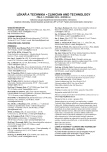Differences in sleep patterns among healthy sleepers and patients after stroke
Sleep deprivation, whether from disorder or lifestyle, whether acute or chronic, poses a significant risk in daytime cognitive performance, excessive somnolence, impaired attention or decreased level of motor abilities. Ischemic stroke resulting in cerebral lesions is a well-known acute disorder that leaves affected patients strongly vulnerable to sleep disturbances that often lead to the above-mentioned cognitive and attentional impairments. In this paper, we analyzed and compared sleep patterns of healthy sleepers and patients after stroke. To overcome the well-known limits of the standardized sleep scoring into several discrete sleep stages we employed the recently proposed probabilistic sleep model that represents the sleep process as a continuum in terms of a set of probability curves. The probability curves were considered to represent a form of functional data, and microstructure along with time dynamics of the curves were studied using functional principal components analysis and clustering. Although our study represents a preliminary attempt to separate the two groups of subjects, we were able to identify several physiologically separate sleep patterns and we also identified sleep microstate patterns being a potential source allowing the discrimination of healthy subjects and stroke patients.
Keywords:
sleep patterns, stroke, probabilistic sleep model, functional principal components analysis
Autoři:
Bui Thi Mai Phuong; Roman Rosipal
Působiště autorů:
Slovak Academy of Sciences, Bratislava, Slovak Republic
; Department of Theoretical Methods, Institute of Measurement Science
Vyšlo v časopise:
Lékař a technika - Clinician and Technology No. 4, 2014, 44, 15-20
Kategorie:
Původní práce
Souhrn
Sleep deprivation, whether from disorder or lifestyle, whether acute or chronic, poses a significant risk in daytime cognitive performance, excessive somnolence, impaired attention or decreased level of motor abilities. Ischemic stroke resulting in cerebral lesions is a well-known acute disorder that leaves affected patients strongly vulnerable to sleep disturbances that often lead to the above-mentioned cognitive and attentional impairments. In this paper, we analyzed and compared sleep patterns of healthy sleepers and patients after stroke. To overcome the well-known limits of the standardized sleep scoring into several discrete sleep stages we employed the recently proposed probabilistic sleep model that represents the sleep process as a continuum in terms of a set of probability curves. The probability curves were considered to represent a form of functional data, and microstructure along with time dynamics of the curves were studied using functional principal components analysis and clustering. Although our study represents a preliminary attempt to separate the two groups of subjects, we were able to identify several physiologically separate sleep patterns and we also identified sleep microstate patterns being a potential source allowing the discrimination of healthy subjects and stroke patients.
Keywords:
sleep patterns, stroke, probabilistic sleep model, functional principal components analysis
Zdroje
[1] Iber, C., Ancoli-Israel, S., Chesson, A. & Quan, S. The AASM Manual for the Scoring of Sleep and Associated Events: Rules, Terminology and Technical Specifications. American Academy of Sleep Medicine, 2007.
[2] Rechtschaffen, A. & Kales, A. A manual of standardized terminology, techniques and scoring system for sleep stages of human subjects. 1968.
[3] Kapen, S., Park, A., Goldberg, J. & Whynter, J. The incidence and severity of obstructive sleep apnea in ischemic cerebrovascular disease. Neurology, 1991, vol. 41, no. 125.
[4] Jiang, B., Ding, C., Yao, G., Yao, C., Zhang, Y., Ge, J., Qiu, E., Elia, M. & Ferri, R. Polysomnographic abnormalities in patients with vascular cognitive impairment - no dementia. Sleep Medicine, 2013, vol. 14, p. 1071–1075.
[5] Klösch, G., Kemp, B., Penzel, T., Schlögl, A., Rappelsberger, P., Trenker, E., et al. The SIESTA project polygraphic and clinical database. Engineering in Medicine and Biology Magazine, 2001, vol. 20, p. 51–57.
[6] Buysse, D. J., Reynolds III, C. F., Monk, T. H., Berman, S. R. & Kupfer, D. J. The Pittsburgh Sleep Quality Index: a new instrument for psychiatric practice and research. Psychiatry Research, 1989, vol. 28, p. 193–213.
[7] Anderer, P., Gruber, G., Parapatics, S., Woertz, M., Miazhynskaia, T., Klösch, G., et al. An E-health solution for automatic sleep classification according to Rechtschaffen and Kales: validation study of the Somnolyzer 24x7 utilizing the SIESTA database. Neuropsychobiology, 2005, vol. 51, p. 115–133.
[8] Lewandowski, A., Rosipal, R. & Dorffner, G. Extracting more information from EEG recordings for a better description of sleep. Computer Methods and Programs in Biomedicine, 2012, vol. 108, p. 961–972.
[9] Rosipal, R., Lewandowski, A. & Dorffner, G. In search of objective components for sleep quality indexing in normal sleep. Biological Psychology, 2013, vol. 94, p. 210–220.
[10] Ramsay, J.O. Functional data analysis. Wiley Online Library, 2006.
[11] Yao, F., Müller, H.G., Clifford, A.J., Dueker, S.R., Follett, J., Lin, Y., et al. Shrinkage estimation for functional principal component scores with application to the population kinetics of plasma folate. Biometrics, 2003, vol. 59, p. 676–685.
Štítky
BiomedicínaČlánok vyšiel v časopise
Lékař a technika

2014 Číslo 4
Najčítanejšie v tomto čísle
- REAL-TIME visualization of multichannel ECG signals using the parallel CPU threads
- Differences in sleep patterns among healthy sleepers and patients after stroke
- Pulmonary fluid accumulation and its influence on the Impedance Cardiogram: CompariSON Between a Clinical Trial AND FEM Simulations
- EFFECT OF THE PLACEMENT OF THE INERTIAL SENSOR ON THE HUMAN MOTION DETECTION
